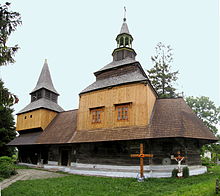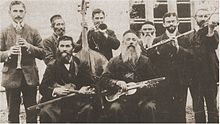Rohatyn
| Rohatyn | ||
| Рогатин | ||

|
|
|
| Basic data | ||
|---|---|---|
| Oblast : | Ivano-Frankivsk Oblast | |
| Rajon : | Rohatyn district | |
| Height : | no information | |
| Area : | 15.00 km² | |
| Residents : | 8,097 (2011) | |
| Population density : | 540 inhabitants per km² | |
| Postcodes : | 77000 | |
| Area code : | +380 3435 | |
| Geographic location : | 49 ° 25 ′ N , 24 ° 37 ′ E | |
| KOATUU : | 2624410100 | |
| Administrative structure : | 1 city | |
| Mayor : | Volodymyr Shtohryn | |
| Address: | вул. Шевченка 4 77000 м. Рогатин |
|
| Website : | rohatyn.ronet.com.ua | |
| Statistical information | ||
|
|
||
Rohatyn ( Ukrainian Рогатин , Russian Рогатин Rogatin , Polish Rohatyn , German also Rohatin ) is a city in western Ukraine with about 8100 inhabitants (2011). Rohatyn is the administrative seat of Rohatyn Raion in the north of Ivano-Frankivsk Oblast .
history
There was a wooden castle complex in Rohatyn since the 10th century. In 1184 the place in the Principality of Halitsch-Volhynien was first mentioned in writing. The area came to Poland in 1340. In 1415, Rohatyn received Magdeburg city rights and subsequently developed into an important trading center. An important school of icon painting emerged in the 16th century , and an important Orthodox monastery was founded in the 1580s .
After the First Partition of Poland , Rohatyn came to the Habsburg Monarchy in 1772 and became part of the later crown land of Galicia . In 1854 the seat of the district administration Rohatyn was established in the place. Together with the district court established in 1867, they existed until 1918.
The local Jewish community dates back to the 16th century. It was granted privileges by King Władysław IV. Wasa in 1633 and was given equal rights by the Austrian government in 1868 . In the 19th century, the majority of the residents were Jews.
The Stryj – Ternopil railway has been running south of the village since 1897 . In 1909 a Ukrainian grammar school was founded.
In 1918 Rohatyn was part of the West Ukrainian People's Republic and in 1919 the city was conquered by the Polish army and from 1921 belonged to the Stanislav Voivodeship within the Second Polish Republic . In 1931 a theological seminary was opened. In the course of the Soviet occupation of eastern Poland , Rohatyn became part of the Soviet Union in the Ukrainian SSR in 1939 . After the German invasion of the Soviet Union in June 1941, it was occupied by the German Reich and attached to the Galicia district . On March 20, 1942, under the direction of Hans Krüger , the head of the security police in Stanislau , 2,300 Jews were shot on site. After 3,500 Jews were deported to the Belzec extermination camp , Krüger had the ghetto liquidated in June 1943 . When Rohatyn was liberated by the Red Army on July 24, 1944, around 30 Jews had survived there.
From that date Rohatyn belonged again to the Soviet Union. After the collapse of the Soviet Union in 1991, it became part of the independent Ukraine .
Reception in art
Rohatyn is a setting in the novel The Books of Jacob by Olga Tokarczuk .
sons and daughters of the town
- Roxelane (1500 / 06–1558), favorite consort of the Ottoman Sultan Suleyman I.
- Norbert Glanzberg (1910–2001), French composer and pianist.
- Felix Milgrom (1919-2007), immunologist and microbiologist
Attractions
The old wooden church on site was added to the UNESCO World Heritage Site in 2013, along with other wooden churches in the Carpathian region in Poland and Ukraine .
literature
- Rohatyn , in: Guy Miron (Ed.): The Yad Vashem encyclopedia of the ghettos during the Holocaust . Jerusalem: Yad Vashem, 2009 ISBN 978-965-308-345-5 , pp. 660f.
Web links
- Rohatyn in the Encyclopedia of Ukraine
- Rohatyn . In: Filip Sulimierski, Władysław Walewski (eds.): Słownik geograficzny Królestwa Polskiego i innych krajów słowiańskich . tape 9 : Poźajście – Ruksze . Walewskiego, Warsaw 1888, p. 694 (Polish, edu.pl ).
- Homepage of the city of Rohatyn ( Memento from October 9, 2007 in the Internet Archive )
- The Jewish Rohatyn at shtetlinks.com
Individual evidence
- ^ Homepage of the city of Rohatyn ( Memento from October 9, 2007 in the Internet Archive )
- ^ Reichsgesetzblatt of April 24, 1854, No. 111, page 401
- ↑ 1857: 5,101 inhabitants, 3,000 of them Jews
- ↑ Dieter Pohl: Hans Krüger - the 'King of Stanislau'. In: Klaus-Michael Mallmann, Gerhard Paul: Careers of violence. National Socialist perpetrator biographies. Darmstadt 2004, ISBN 3-534-16654-X , p. 186 / number 3000 by Dieter Schenk: The Lviv Professors Murder and the Holocaust in East Galicia. Bonn 2007, ISBN 978-3-8012-5033-1 , p. 186.
- ↑ https://www.deutschlandfunk.de/olga-tokarczuk-die-jakobsbuecher-panorama-einer.700.de.html?dram:article_id=460785






